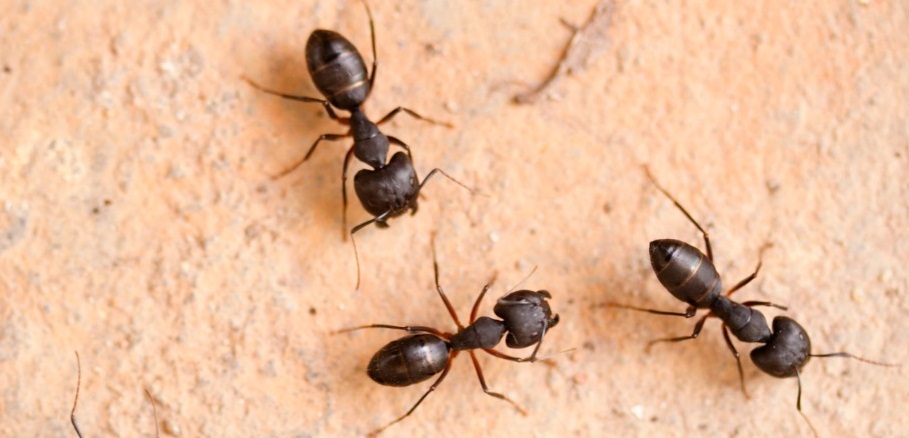
Carpenter ants can be found both indoors and outdoors, particularly in hollow, moist, or decaying wood areas. Much like termites, these destructive ants cut galleries through the wood in order to create passageways that allow them to move from place to place within their colonies. Carpenter ants are much larger than most other ant species; measuring from ¼ inch to an inch in length. There are approximately 1,000 carpenter ant species found throughout the world; however in the United States, the most common species is the black carpenter ant, Camponotus Pennsylvanicus. In this guide covering how to get rid of carpenter ants, this is the species being discussed although methods, including those concerning how to get rid of carpenter ants naturally, will work on other species as well.
Identifying carpenter ants is quite easy, particularly if they have invaded your home or another structure. Though various carpenter ant species have black to brown bodies, black carpenter ants are a solid black to dark brownish black color, with long antennae. Worker ants, which you’re most likely to see, are an average of one to two centimeters in length, while queens and winged reproductive carpenter ants can be as much as an inch long.
These ants prefer to inhabit roof eaves, the areas under and around windows, and outside areas such as decks and porches, mostly because these areas tend to be most vulnerable to moisture. A large colony will produce crackling sounds as they chew; when thousands of individuals are present, this sound can be heard when other noises, such as TV and radio, have been muted.
Unlike termites, carpenter ants do not actually consume the wood they chew through; they leave little heaps of sawdust called frass behind, which can serve as a telltale sign that they are present within a structure. Carpenter ants are omnivorous, mainly consuming plants, plant juices, and other insects; they also eat meat, fat, and grease, and they have a strong preference for sweets, including honey, syrup, jelly, sugar, and fruit. They forage fairly long distances – up to 100 yards – in search of food sources, and are most active at night.
How to Get Rid of Carpenter Ants
The first step in eliminating carpenter ants is to locate the nest and determine how the ants are entering. Look for damp areas, particularly places where wood is in contact with the ground. Areas where plumbing is present, points where condensation tends to accumulate, and moisture from air conditioners all serve as oases for carpenter ants, so be sure to look in these areas. In addition, check areas near gutters and downspouts for activity. Keep an eye out for small piles of frass, which are almost always present beneath entry and exit points; in massive colonies, bubbling paint can also serve as a signal that carpenter ants have invaded.
You can also watch for the ants themselves, either keeping an eye out for exiting foragers or watching for foragers as they return to their nests. You can set honey or sugar out for the ants in order to draw their attention; this can make your search easier. If you see winged carpenter ants, following them will typically be pointless as they are usually departing in search of a mate; however, the mere presence of winged carpenter ants indicates that you could have a serious infestation on your hands.
The second step in getting rid of carpenter ants is to create a plan for dealing with them. As with termites, killing visible carpenter ants is not sufficient to eliminate the nest. There are two ways to get pesticide into the nest, where it will kill the majority of the colony’s members:
- Spray an aerosol pesticide into the nest’s entrance, and place sweet ant baits near the nest’s entry point. This is sometimes effective in completely eliminating a small carpenter ant infestation, and it is a good first step in getting rid of a larger nest.
- Drill holes into the wall in order to penetrate the nest, being careful not to allow the ants to bite you in the process. They defend their nests aggressively and their bites are very painful. Spray carpenter ant pesticide into the holes and dust the area with boric acid or a powdered pesticide. This will need to be repeated until signs of activity have ceased.
How to Get Rid of Carpenter Ants Naturally
The most effective method for getting rid of carpenter ants naturally is to use diatomaceous earth (DE) which is a completely organic, natural substance, which has microscopic edges that are razor sharp, and that completely destroy the insects’ bodies. When shopping for diatomaceous earth, choose food grade DE rather than the type which is added to swimming pools. Food grade DE is safe for use around pets and children.
In order to eliminate carpenter ants with DE, the substance needs to be injected directly into the ants’ colony, either by drilling holes into the colony or by using a hand duster made specifically for applying diatomaceous earth and other granules to ants’ nests so make sure you use the best cordless drill available. Apply the DE every few days until signs of activity come to a stop, and be sure to reapply after rain, if applicable.
Preventing Future Carpenter Ant Infestations
Once you have eliminated the carpenter ants from your property, it is vital that you work to control the environment to prevent a future infestation. Any damp or damaged wood should be dried out or replaced. Sprinkle diatomaceous earth around your home’s perimeter, and watch carefully for signs of carpenter ant re-infestation, and consider placing white gravel around your home’s perimeter, since this is an effective deterrent.
